Assessment of the Impact of Climate Change on Streamflow and Sediment in the Nagavali and Vamsadhara Watersheds in India
Abstract
1. Introduction
2. Materials and Methods
2.1. Study Area
2.2. Datasets
2.2.1. Spatial Data
2.2.2. Weather Data
2.2.3. Climate Models Data
2.2.4. Shared Socio-Economic Pathways (SSPs)
2.2.5. Hydrological Data
2.3. Methodology
2.4. Model Setup
2.5. Selection and Shortlisting of Downscaled GCMs
3. Results and Discussion
3.1. Shortlisting of Climate Models
3.2. Consequence of Climate Change on Precipitation
3.3. Implications of Climate Change on Streamflow
3.4. Implications of Climate Change on Sediment Yield
3.5. Spatial Distribution of Precipitation, Streamflow and Sediment Yield under Dry-Warm and Cold-Wet Models
4. Conclusions
Author Contributions
Funding
Institutional Review Board Statement
Informed Consent Statement
Data Availability Statement
Conflicts of Interest
References
- Sridhar, V.; Anderson, K.A. Human-induced modifications to boundary layer fluxes and their water management implications in a changing climate. Agric. For. Meteorol. 2017, 234, 66–79. [Google Scholar] [CrossRef]
- Seong, C.; Sridhar, V.; Billah, M.M. Implications of potential evapotranspiration methods for streamflow estimation in a changing climate. Int. J. Clim. 2018, 38, 896–914. [Google Scholar] [CrossRef]
- Ma, D.; Xu, Y.-P.; Xuan, W.; Gu, H.; Sun, Z.; Bai, Z. Do model parameters change under changing climate and land use in the upstream of the Lancang River Basin, China? Hydrol. Sci. J. 2020, 65, 1894–1908. [Google Scholar] [CrossRef]
- de Oliveira, V.A.; de Mello, C.R.; Viola, M.R.; Srinivasan, R. Assessment of climate change impacts on streamflow and hydropower potential in the headwater region of the Grande river basin, Southeastern Brazil. Int. J. Climatol. 2017, 37, 5005–5023. [Google Scholar] [CrossRef]
- Zhong, R.; Zhao, T.; He, Y.; Chen, X. Hydropower change of the water tower of Asia in 21st century: A case of the Lancang River hydropower base, upper Mekong. Energy 2019, 179, 685–696. [Google Scholar] [CrossRef]
- Ma, D.; Xu, Y.P.; Gu, H.; Zhu, Q.; Sun, Z.; Xuan, W. Role of satellite and reanalysis precipitation products in streamflow and sediment modeling over a typical alpine and gorge region in Southwest China. Sci. Total. Environ. 2019, 685, 934–950. [Google Scholar] [CrossRef]
- Intergovernmental Panel on Climate Change (IPCC). Climate Change 2014: Synthesis Report; IPCC: Geneva, Switzerland, 2014; pp. 1–15.
- Singh, L.; Saravanan, S. Impact of climate change on hydrology components using CORDEX South Asia climate model in Wunna, Bharathpuzha, and Mahanadi, India. Environ. Monit. Assess. 2020, 192, 1–21. [Google Scholar] [CrossRef]
- Kumar, K.S.; Rathnam, E.V.; Sridhar, V. Tracking seasonal fluctuations of drought indices with GRACE terrestrial water storage over major river basins in South India. Sci. Total. Environ. 2020, 763, 142994. [Google Scholar] [CrossRef]
- Aggarwal, R.; Kaushal, M.; Kaur, S.; Farmaha, B. Water resource management for sustainable agriculture in Punjab, India. Water Sci. Technol. 2009, 60, 2905–2911. [Google Scholar] [CrossRef]
- Nilawar, A.P.; Waikar, M.L. Impacts of climate change on streamflow and sediment concentration under RCP 4.5 and 8.5: A case study in Purna river basin, India. Sci. Total. Environ. 2019, 650, 2685–2696. [Google Scholar] [CrossRef]
- Sujatha, E.R.; Sridhar, V. Mapping Debris Flow Susceptibility using Analytical Network Process. J. Earth Syst. Sci. 2017, 126, 116. [Google Scholar] [CrossRef]
- Sujatha, E.R.; Sridhar, V. Landslide Susceptibility Analysis in the Era of Climate Change: A Logistic Regression Model Case Study in Coonoor, India. Hydrology 2021, 8, 41. [Google Scholar] [CrossRef]
- Ibrahim, K.S.M.H.; Huang, Y.F.; Ahmed, A.N.; Koo, C.H.; El-Shafie, A. A review of the hybrid artificial intelligence and optimization modelling of hydrological streamflow forecasting. Alex. Eng. J. 2022, 61, 279–303. [Google Scholar] [CrossRef]
- Latif, S.D.; Ahmed, A.N. A review of deep learning and machine learning techniques for hydrological inflow forecasting. Environ. Dev. Sustain. 2023, 2023, 1–28. [Google Scholar] [CrossRef]
- Hoekema, D.J.; Sridhar, V. A System Dynamics Model for Conjunctive Management of Water Resources in the Snake River Basin. J. Am. Water Resour. Assoc. 2013, 49, 1327–1350. [Google Scholar] [CrossRef]
- Reddy, N.N.; Reddy, K.V.; Vani, J.S.L.S.; Daggupati, P.; Srinivasan, R. Climate change impact analysis on watershed using QSWAT. Spat. Inf. Res. 2018, 26, 253–259. [Google Scholar] [CrossRef]
- Mohseni, U.; Agnihotri, P.G.; Pande, C.B.; Durin, B. Understanding the Climate Change and Land Use Impact on Streamflow in the Present and Future under CMIP6 Climate Scenarios for the Parvara Mula Basin, India. Water 2023, 15, 1753. [Google Scholar] [CrossRef]
- Maurya, S.; Srivastava, P.K.; Zhuo, L.; Yaduvanshi, A.; Mall, R.K. Future Climate Change Impact on the Streamflow of Mahi River Basin under Different General Circulation Model Scenarios. Water Resour. Manag. 2023, 37, 2675–2696. [Google Scholar] [CrossRef]
- Mahdian, M.; Hosseinzadeh, M.; Siadatmousavi, S.M.; Chalipa, Z.; Delavar, M.; Guo, M.; Abolfathi, S.; Noori, R. Modelling impacts of climate change and anthropogenic activities on inflows and sediment loads of wetlands: Case study of the Anzali wetland. Sci. Rep. 2023, 13, 5399. [Google Scholar] [CrossRef]
- Kang, H.; Sridhar, V.; Mainuddin, M.; Trung, L.D. Future rice farming threatened by drought in the Lower Mekong Basin. Nat. Sci. Rep. 2021, 11, 9383. [Google Scholar] [CrossRef]
- Sridhar, V.; Ali, S.A.; Sample, D.J. Systems Analysis of Coupled Natural and Human Processes in the Mekong River Basin. Hydrology 2021, 8, 140. [Google Scholar] [CrossRef]
- Seong, C.H.; Sridhar, V. Hydroclimatic variability and change in the Chesapeake Bay Watershed. J. Water Clim. Chang. 2016, 8, 254–273. [Google Scholar] [CrossRef]
- Tiwari, R.; Mishra, A.K.; Rai, S.; Pandey, L.K. Evaluation and projection of northeast monsoon precipitation over India under higher warming scenario: A multimodel assessment of CMIP6. Theor. Appl. Clim. 2023, 151, 859–870. [Google Scholar] [CrossRef]
- Shiru, M.S.; Chung, E.S. Performance evaluation of CMIP6 global climate models for selecting models for climate projection over Nigeria. Theor. Appl. Clim. 2021, 146, 599–615. [Google Scholar] [CrossRef]
- Kang, H.; Sridhar, V.; Ali, S.A. Climate change impacts on conventional and flash droughts in the Mekong River Basin. Sci. Total. Environ. 2022, 838 Pt 2, 155845. [Google Scholar] [CrossRef]
- Kang, H.; Sridhar, V. A novel approach combining simulated soil moisture and stochastic techniques to forecasting drought in the Mekong River basin. Int. J. Clim. 2020, 41, E2497–E2516. [Google Scholar] [CrossRef]
- Kang, H.; Sridhar, V.; Mills, B.; Hession, W.C.; Ogejo, J.A. Economy-Wide Climate Change Impacts on Green Water Droughts Based on the Hydrologic Simulations. Agric. Syst. 2019, 171, 76–88. [Google Scholar] [CrossRef]
- Setti, S.; Maheswaran, R.; Sridhar, V.; Barik, K.K.; Merz, B.; Agarwal, A. Inter-Comparison of Gauge-Based Gridded Data, Reanalysis and Satellite Precipitation Product with an Emphasis on Hydrological Modeling. Atmosphere 2020, 11, 1252. [Google Scholar] [CrossRef]
- Setti, S.; Maheswaran, R.; Radha, D.; Sridhar, V.; Barik, K.K.; Narasimham, M.L. Attribution of hydrologic changes in a tropical river basin to climate and land use change: A case study from India. ASCE J. Hydrol. Eng. 2020, 25, 05020015. [Google Scholar] [CrossRef]
- Ma, D.; Qian, B.; Gu, H.; Sun, Z.; Xu, Y.P. Assessing climate change impacts on streamflow and sediment load in the upstream of the Mekong River basin. Int. J. Clim. 2021, 41, 3391–3410. [Google Scholar] [CrossRef]
- Pandey, A.; Palmate, S.S. Assessing future water–sediment interaction and critical area prioritization at sub-watershed level for sustainable management. Paddy Water Environ. 2019, 17, 373–382. [Google Scholar] [CrossRef]
- Azari, M.; Moradi, H.R.; Saghafian, B.; Faramarzi, M. Climate change impacts on streamflow and sediment yield in the North of Iran. Hydrol. Sci. J. 2016, 61, 123–133. [Google Scholar] [CrossRef]
- Jin, L.; Whitehead, P.G.; Rodda, H.; Macadam, I.; Sarkar, S. Simulating climate change and socio-economic change impacts on flows and water quality in the Mahanadi River system, India. Sci. Total. Environ. 2018, 637, 907–917. [Google Scholar] [CrossRef]
- Rao, K.K.; Kulkarni, A.; Patwardhan, S.; Kumar, B.V.; Kumar, T.V.L. Future changes in precipitation extremes during northeast monsoon over south peninsular India. Theor. Appl. Clim. 2020, 142, 205–217. [Google Scholar] [CrossRef]
- Mishra, V.; Bhatia, U.; Tiwari, A.D. Bias-corrected climate projections for South Asia from Coupled Model Intercomparison Project-6. Sci. Data 2020, 7, 1–13. [Google Scholar] [CrossRef]
- Hengade, N.; Eldho, T.I.; Ghosh, S. Climate change impact assessment of a river basin using CMIP5 climate models and the VIC hydrological model. Hydrol. Sci. J. 2018, 63, 596–614. [Google Scholar] [CrossRef]
- Pandey, B.K.; Gosain, A.K.; Paul, G.; Khare, D. Climate change impact assessment on hydrology of a small watershed using semi-distributed model. Appl. Water Sci. 2017, 7, 2029–2041. [Google Scholar] [CrossRef]
- Swain, S. Impact of climate variability over Mahanadi river basin. Int. J. Eng. Res. Technol. 2014, 3, 938–943. [Google Scholar]
- CWC. Compendium on sedimentation of reservoirs in India. In Water Planning and Projects Wing, Environment Management Organisation, Watershed and Reservoir Sedimentation Directorate, Central Water Commission; Government of India: New Delhi, India, 2020. [Google Scholar]
- Eadara, A.; Kannam, H. Slope studies of Vamsadhara River basin: A Quantitative Approach. Int. J. Eng. Innov. Technol. 2013, 3, 184–188. [Google Scholar]
- Rao, G.V.; Reddy, K.V.; Srinivasan, R.; Sridhar, V.; Umamahesh, N.V.; Pratap, D. Spatio-temporal analysis of rainfall extremes in the flood-prone Nagavali and Vamsadhara Basins in eastern India. Weather. Clim. Extrem. 2020, 29, 100265. [Google Scholar] [CrossRef]
- Rao, G.V.; Reddy, K.V.; Sridhar, V. Sensitivity of Microphysical Schemes on the Simulation of Post-Monsoon Tropical Cyclones over the North Indian Ocean. Atmosphere 2020, 11, 1297. [Google Scholar] [CrossRef]
- Ge, F.; Zhu, S.; Luo, H.; Zhi, X.; Wang, H. Future changes in precipitation extremes over Southeast Asia: Insights from CMIP6 multi-model ensemble. Environ. Res. Lett. 2021, 16, 024013. [Google Scholar] [CrossRef]
- Mishra, V.; Bhatia, U.; Tiwari, A.D. Bias Corrected Climate Projections from CMIP6 Models for Indian Sub-Continental River Basins [Data set]. Zenodo. Available online: https://doi.org/10.5281/zenodo.3874046 (accessed on 24 June 2023).
- Kebede, A.S.; Nicholls, R.J.; Allan, A.; Arto, I.; Cazcarro, I.; Fernandes, J.A.; Hill, C.T.; Hutton, C.W.; Kay, S.; Lázár, A.N.; et al. Applying the global RCP–SSP–SPA scenario framework at sub-national scale: A multi-scale and participatory scenario approach. Sci. Total. Environ. 2018, 635, 659–672. [Google Scholar] [CrossRef]
- Nagireddy, N.R.; Keesara, V.R.; Sridhar, V.; Srinivasan, R. Streamflow and Sediment Yield Analysis of Two Medium-Sized East-Flowing River Basins of India. Water 2022, 14, 2960. [Google Scholar] [CrossRef]
- Neitsch, S.L.; Arnold, J.G.; Kiniry, J.R.; Williams, J.R. Soil and Water Assessment Tool Theoretical Documentation Version 2009; Texas Water Resources Institute: College Station, TX, USA, 2011. [Google Scholar]
- Arnold, J.G.; Moriasi, D.N.; Gassman, P.W.; Abbaspour, K.C.; White, M.J.; Srinivasan, R.; Santhi, C.; Harmel, R.D.; Van Griensven, A.; Van Liew, M.W.; et al. SWAT: Model use, calibration, and validation. Trans. ASABE 2012, 55, 1491–1508. [Google Scholar] [CrossRef]
- Gassman, P.W.; Reyes, M.R.; Green, C.H.; Arnold, J.G. The Soil and Water Assessment Tool: Historical Development, Applications, and Future Research Directions. Trans. ASABE 2007, 50, 1211–1250. [Google Scholar] [CrossRef]
- Douglas-Mankin, K.R.; Srinivasan, R.; Arnold, J.G. Soil and Water Assessment Tool (SWAT) Model: Current Developments and Applications. Trans. ASABE 2010, 53, 1423–1431. [Google Scholar] [CrossRef]
- Wilby, R.L.; Dawson, C.W.; Murphy, C.; O’connor, P.O.; Hawkins, E. The Statistical DownScaling Model-Decision Centric (SDSM-DC): Conceptual basis and applications. Clim. Res. 2014, 61, 259–276. [Google Scholar] [CrossRef]
- Khan, A.J.; Koch, M. Selecting and Downscaling a Set of Climate Models for Projecting Climatic Change for Impact Assessment in the Upper Indus Basin (UIB). Climate 2018, 6, 89. [Google Scholar] [CrossRef]
- Moriasi, D.N.; Arnold, J.G.; van Liew, M.W.; Bingner, R.L.; Harmel, R.D.; Veith, T.L. Model evaluation guidelines for systematic quantification of accuracy in watershed simulations. Trans. ASABE 2007, 50, 885–900. [Google Scholar] [CrossRef]
- Setti, S.; Rathinasamy, M.; Chandramouli, S. Assessment of water balance for a forest dominated coastal river basin in India using a semi distributed hydrological model. Model. Earth Syst. Environ. 2018, 4, 127–140. [Google Scholar] [CrossRef]


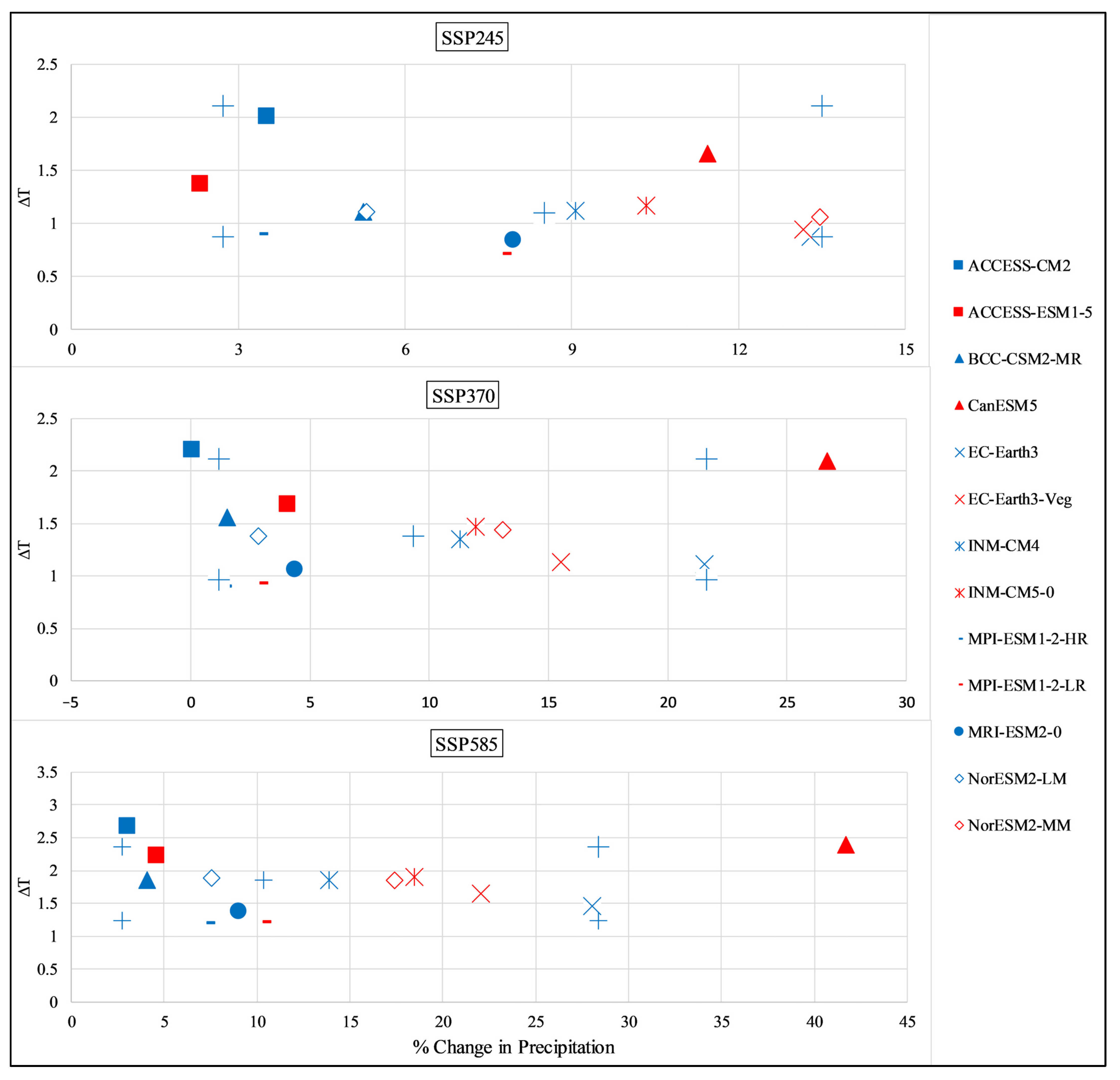
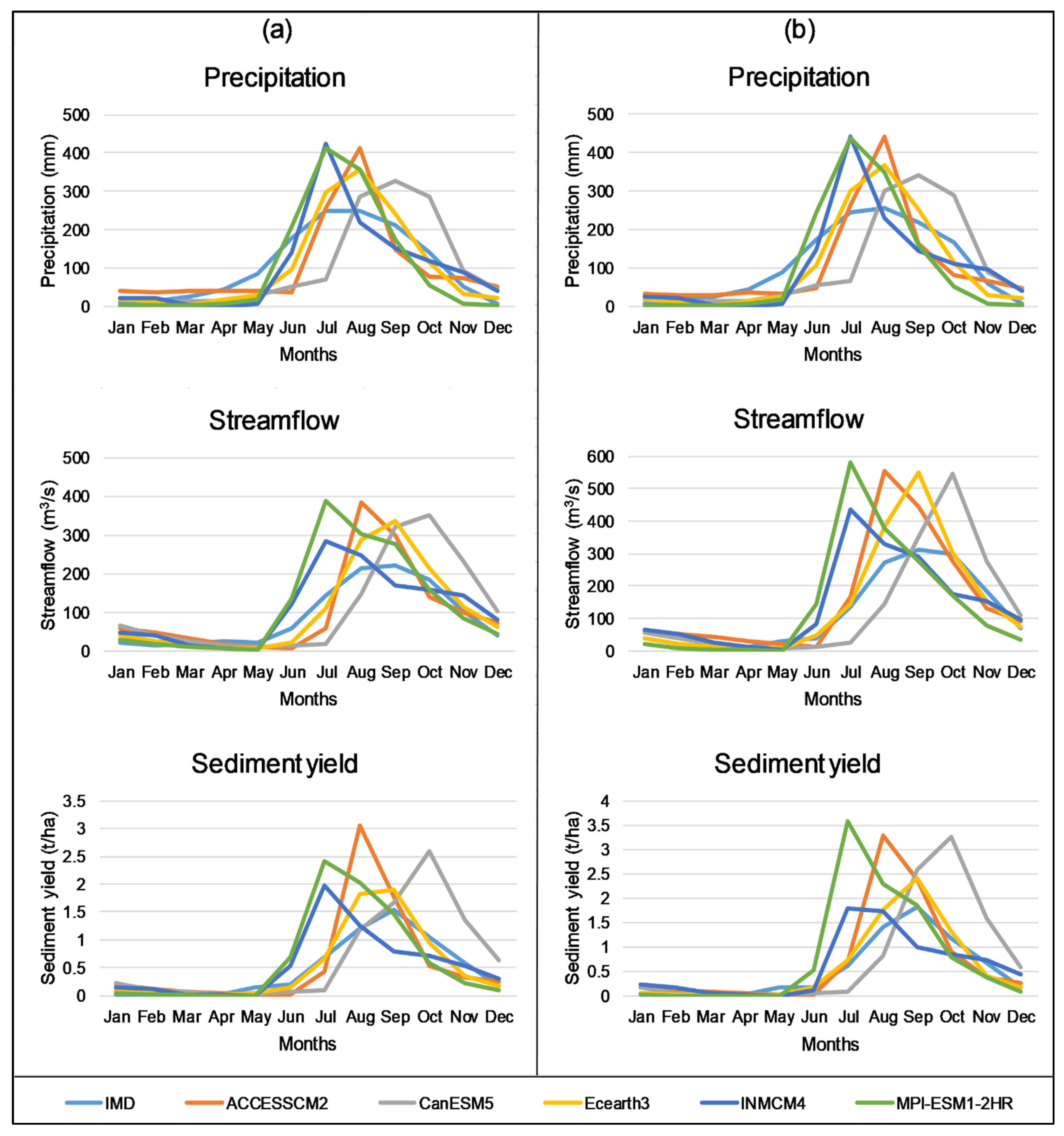
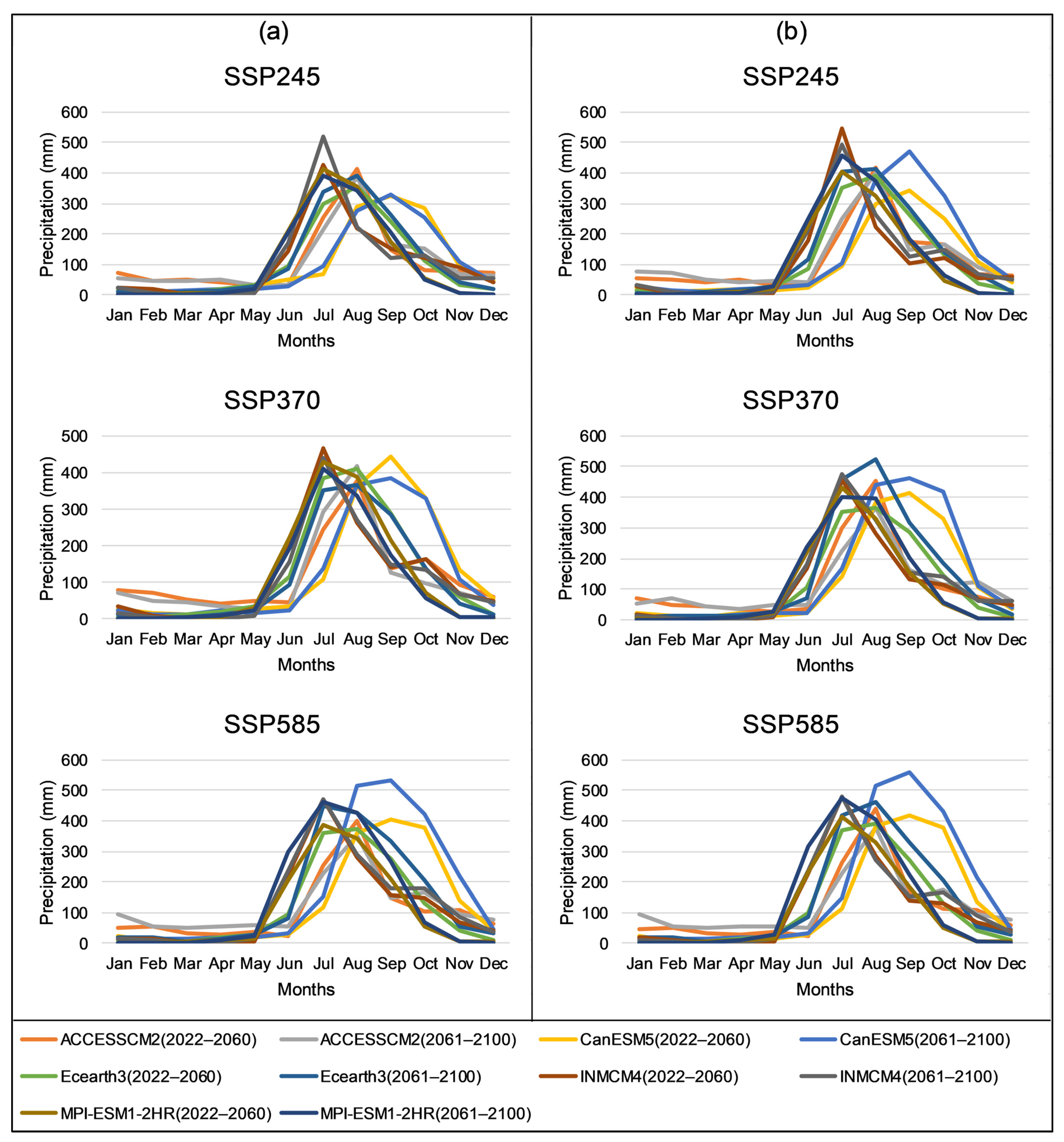
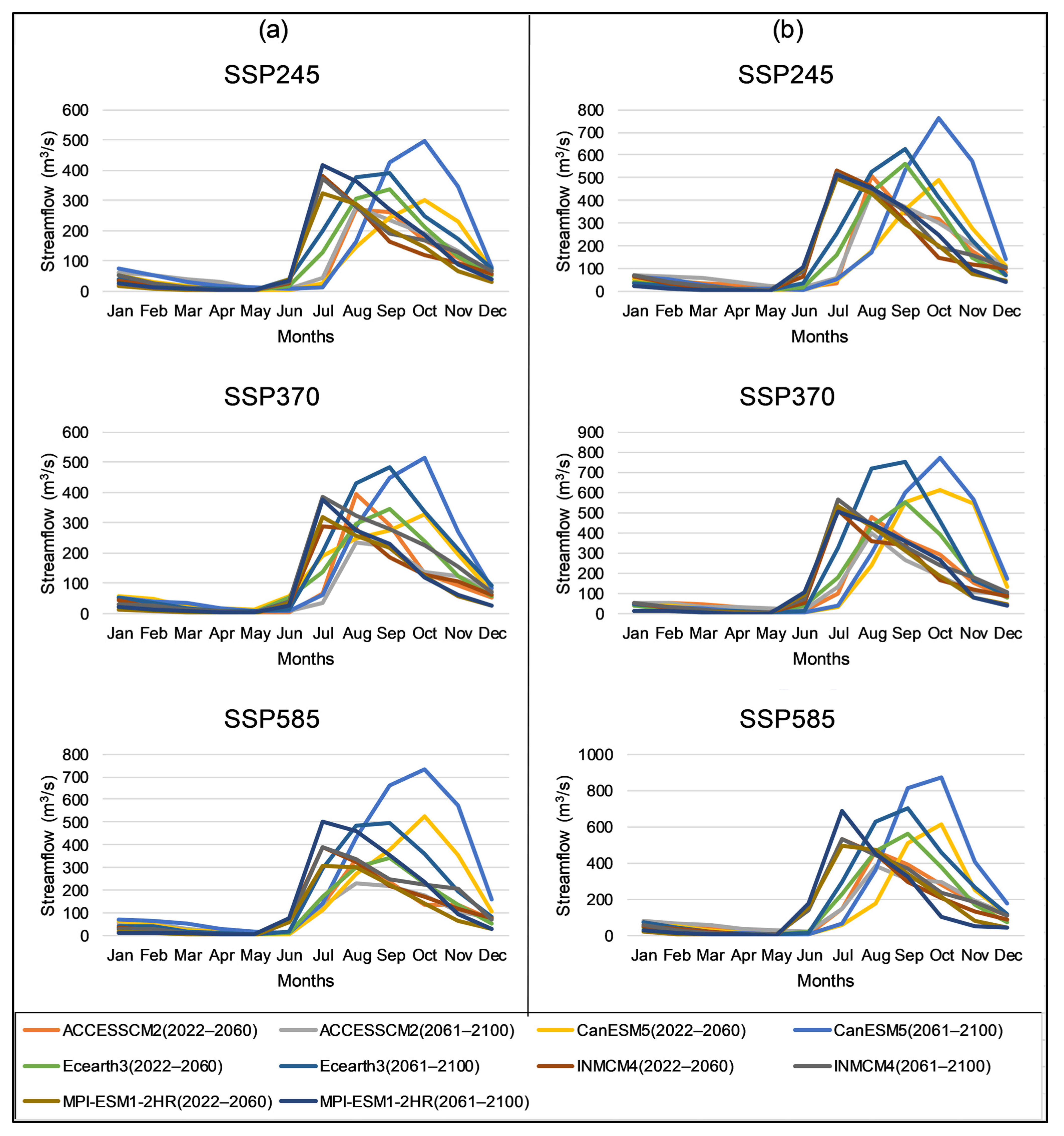
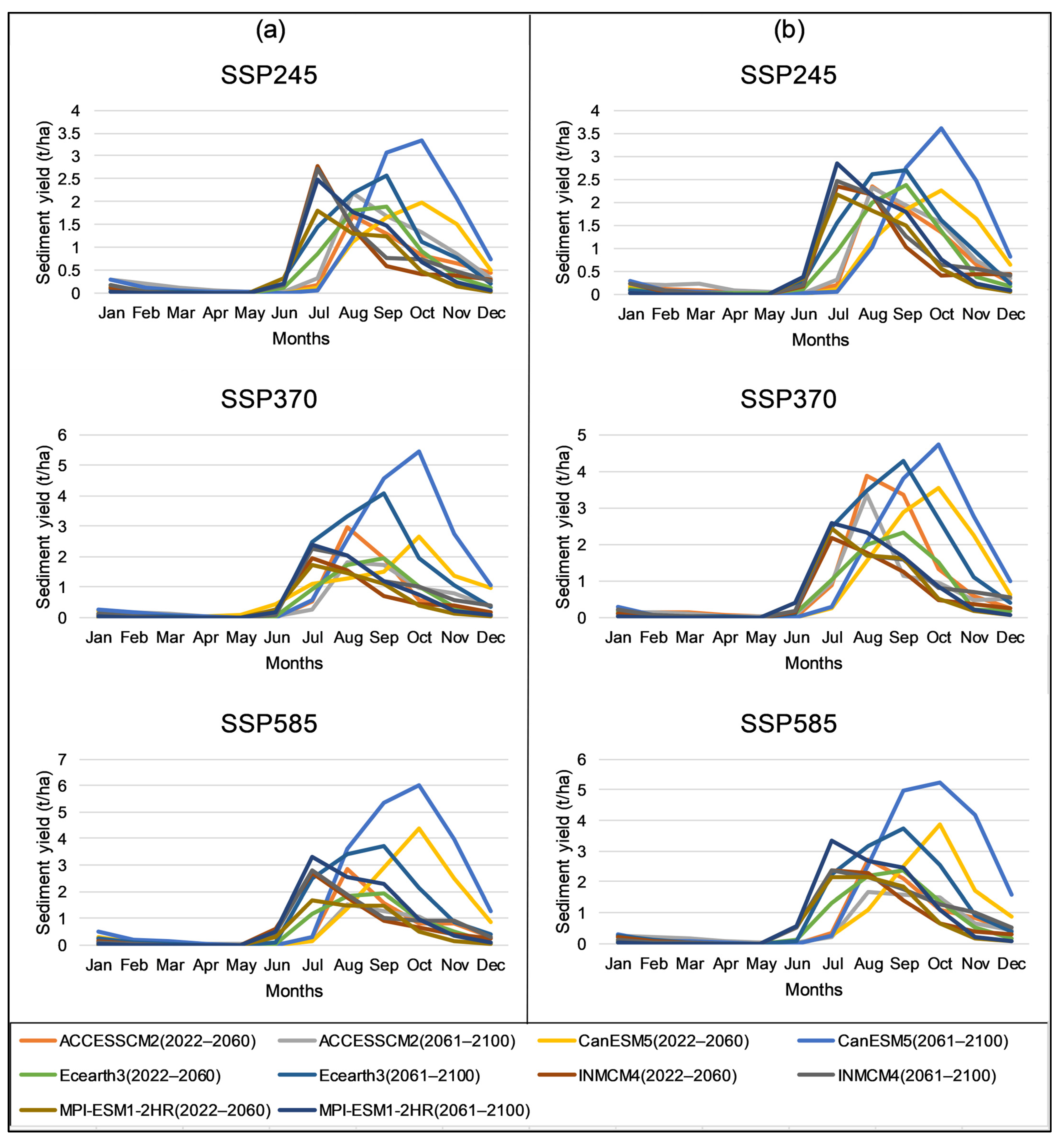
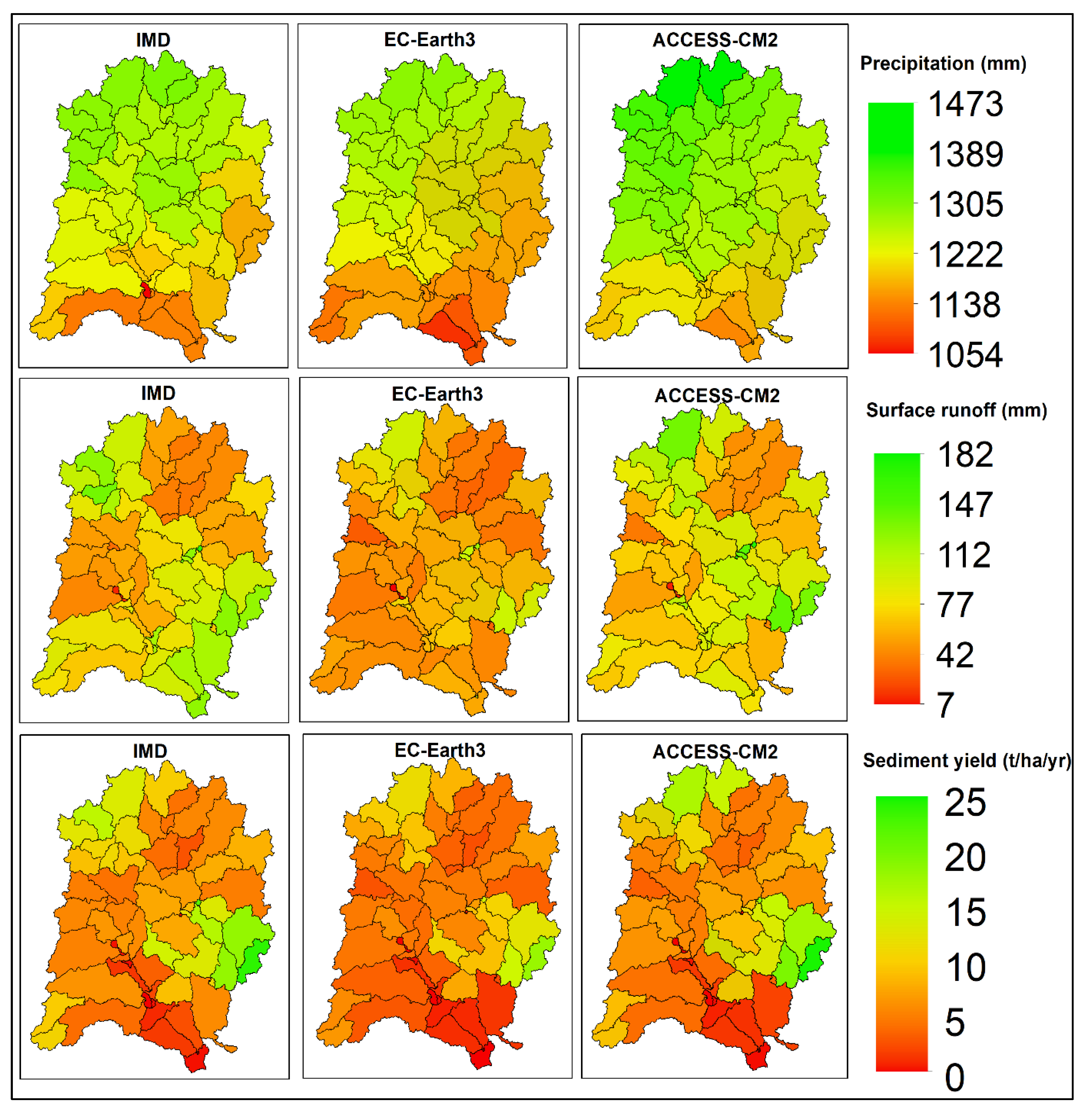
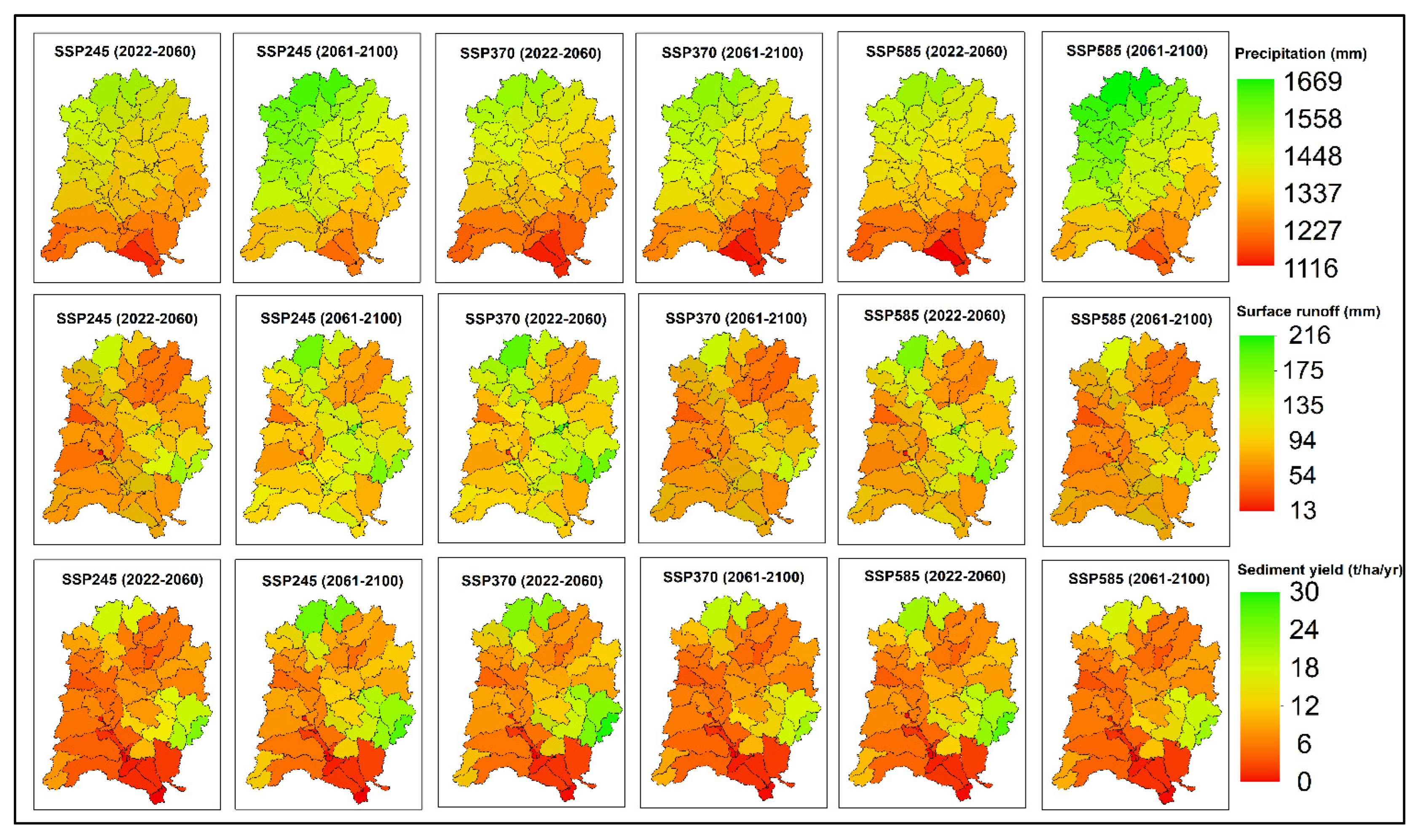
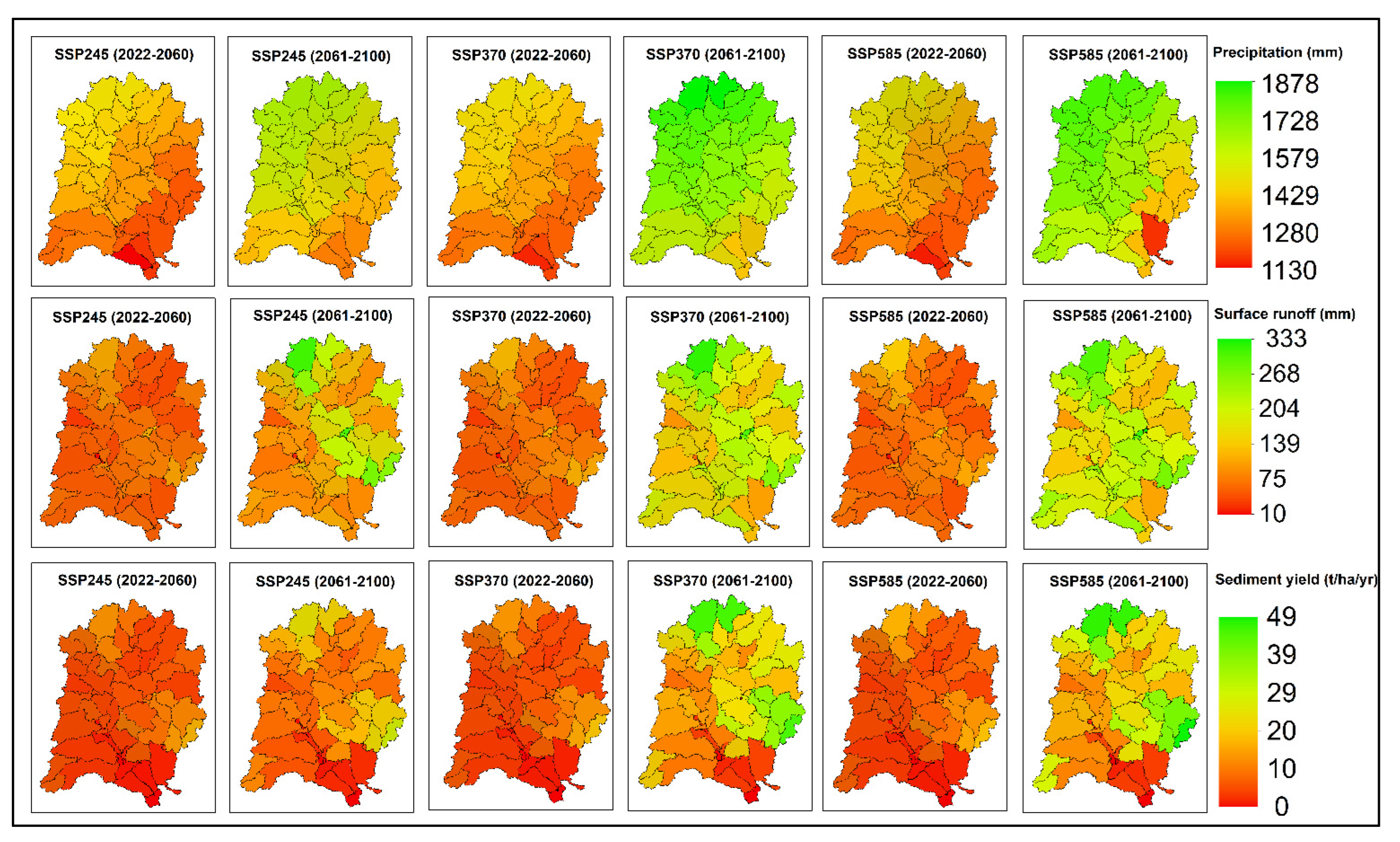
| S.No | Model Representing Corners in the Full Spectrum | Selection Criteria |
|---|---|---|
| 1 | Cold-Dry | 10th percentile of %(ΔP) as well as 10th percentile of ΔT |
| 2 | Cold-Wet | 90th percentile of %(ΔP) as well as 10th percentile of ΔT |
| 3 | Warm-Wet | 90th percentile of %(ΔP) as well as 90th percentile of ΔT |
| 4 | Warm-Dry | 10th percentile of %(ΔP) as well as 90th percentile of ΔT |
| 5 | Average | 50th percentile of %(ΔP) as well as 50th percentile of ΔT |
| Model Name | Representing Scenario |
|---|---|
| CanESM5 | Warm-Wet |
| Ecearth3 | Cold-Wet |
| INMCM4 | Average |
| MPI-ESM1-2HR | Cold-Dry |
| ACCESS-CM2 | Warm-Dry |
| Model Name | % Bias in Precipitation | |
|---|---|---|
| Nagavali River Basin | Vamsadhara River Basin | |
| Ecearth3 | +1.59 | +3.49 |
| MPI-ESM1-2HR | +0.63 | +2.36 |
| CanESM5 | +0.69 | +3.32 |
| ACCESS-CM2 | −4.73 | −2.86 |
| INMCM4 | +1.29 | +3.71 |
| SSP Scenario | Period | Representing Scenario | % Change in Precipitation | |
|---|---|---|---|---|
| NRB | VRB | |||
| SSP245 | Near future (2022–2060) | Warm-Wet | −4.51 | −2.06 |
| Cold-Wet | +7.51 | +5.35 | ||
| Average | +5.66 | +4.47 | ||
| Cold-Dry | −1.33 | −4.60 | ||
| Warm-Dry | −0.17 | +0.96 | ||
| Far future (2061–2100) | Warm-Wet | +25.52 | +24.58 | |
| Cold-Wet | +19.91 | +18.04 | ||
| Average | +13.27 | +11.74 | ||
| Cold-Dry | +10.29 | +7.80 | ||
| Warm-Dry | +7.89 | +6.49 | ||
| SSP370 | Near future (2022–2060) | Warm-Wet | +17.79 | +19.30 |
| Cold-Wet | +8.30 | +7.06 | ||
| Average | +4.29 | +2.54 | ||
| Cold-Dry | −2.68 | −3.55 | ||
| Warm-Dry | −0.51 | +0.45 | ||
| Far future (2061–2100) | Warm-Wet | +36.41 | +35.93 | |
| Cold-Wet | +34.73 | +34.60 | ||
| Average | +19.45 | +13.53 | ||
| Cold-Dry | +7.57 | +4.34 | ||
| Warm-Dry | +1.65 | −0.24 | ||
| SSP585 | Near future (2022–2060) | Warm-Wet | +23.88 | +22.87 |
| Cold-Wet | +9.27 | +7.69 | ||
| Average | +14.32 | +10.60 | ||
| Cold-Dry | −1.09 | −2.50 | ||
| Warm-Dry | −1.57 | +0.44 | ||
| Far future (2061–2100) | Warm-Wet | +60.51 | +59.09 | |
| Cold-Wet | +35.10 | +31.38 | ||
| Average | +22.11 | +16.35 | ||
| Cold-Dry | +25.52 | +19.46 | ||
| Warm-Dry | +8.48 | +7.51 | ||
| SSP Scenario | Period | Representing Scenario | % Change in Streamflow | % Change in Sediment Yield | ||
|---|---|---|---|---|---|---|
| NRB | VRB | NRB | VRB | |||
| SSP245 | Near future (2022–2060) | Warm-Wet | −10.94 | −0.83 | −12.08 | +2.58 |
| Cold-Wet | +5.62 | +5.75 | +1.93 | +6.14 | ||
| Average | +1.96 | +7.32 | +4.63 | +3.11 | ||
| Cold-Dry | −6.08 | −11.24 | −8.96 | −8.91 | ||
| Warm-Dry | −7.85 | −4.61 | −15.59 | −3.72 | ||
| Far future (2061–2100) | Warm-Wet | +41.19 | +40.39 | +37.23 | +44.38 | |
| Cold-Wet | +27.91 | +26.98 | +44.91 | +43.45 | ||
| Average | +11.75 | +14.67 | +14.08 | +17.11 | ||
| Cold-Dry | +7.24 | +9.54 | +4.47 | +6.27 | ||
| Warm-Dry | +3.43 | +0.42 | +7.96 | +5.65 | ||
| SSP370 | Near future (2022–2060) | Warm-Wet | +32.68 | +38.01 | +32.06 | +46.99 |
| Cold-Wet | +3.21 | +7.28 | +1.09 | +7.12 | ||
| Average | +1.62 | +0.24 | −6.71 | −3.02 | ||
| Cold-Dry | −21.53 | −9.78 | −28.62 | −12.82 | ||
| Warm-Dry | −6.47 | +3.56 | −1.08 | +16.65 | ||
| Far future (2061–2100) | Warm-Wet | +77.71 | +70.03 | +121.86 | +94.21 | |
| Cold-Wet | +69.31 | +60.88 | +129.78 | +107.62 | ||
| Average | +35.05 | +19.21 | +35.10 | +21.04 | ||
| Cold-Dry | +4.38 | +3.78 | +5.97 | +2.27 | ||
| Warm-Dry | −9.68 | −12.06 | −5.28 | −12.49 | ||
| SSP585 | Near future (2022–2060) | Warm-Wet | +39.27 | +38.71 | +56.54 | +36.06 |
| Cold-Wet | +5.88 | +10.26 | +6.62 | +15.19 | ||
| Average | +21.51 | +16.72 | +30.92 | +18.02 | ||
| Cold-Dry | −15.78 | −6.77 | −20.99 | −3.57 | ||
| Warm-Dry | −2.38 | +1.45 | +2.48 | +4.13 | ||
| Far future (2061–2100) | Warm-Wet | +134.41 | +110.60 | +166.49 | +148.67 | |
| Cold-Wet | +68.89 | +53.04 | +123.34 | +95.03 | ||
| Average | +39.35 | +22.38 | +40.24 | +39.54 | ||
| Cold-Dry | +37.84 | +29.89 | +45.54 | +32.65 | ||
| Warm-Dry | −7.71 | −7.55 | −5.27 | −6.71 | ||
Disclaimer/Publisher’s Note: The statements, opinions and data contained in all publications are solely those of the individual author(s) and contributor(s) and not of MDPI and/or the editor(s). MDPI and/or the editor(s) disclaim responsibility for any injury to people or property resulting from any ideas, methods, instructions or products referred to in the content. |
© 2023 by the authors. Licensee MDPI, Basel, Switzerland. This article is an open access article distributed under the terms and conditions of the Creative Commons Attribution (CC BY) license (https://creativecommons.org/licenses/by/4.0/).
Share and Cite
Nagireddy, N.R.; Keesara, V.R.; Venkata Rao, G.; Sridhar, V.; Srinivasan, R. Assessment of the Impact of Climate Change on Streamflow and Sediment in the Nagavali and Vamsadhara Watersheds in India. Appl. Sci. 2023, 13, 7554. https://doi.org/10.3390/app13137554
Nagireddy NR, Keesara VR, Venkata Rao G, Sridhar V, Srinivasan R. Assessment of the Impact of Climate Change on Streamflow and Sediment in the Nagavali and Vamsadhara Watersheds in India. Applied Sciences. 2023; 13(13):7554. https://doi.org/10.3390/app13137554
Chicago/Turabian StyleNagireddy, Nageswara Reddy, Venkata Reddy Keesara, Gundapuneni Venkata Rao, Venkataramana Sridhar, and Raghavan Srinivasan. 2023. "Assessment of the Impact of Climate Change on Streamflow and Sediment in the Nagavali and Vamsadhara Watersheds in India" Applied Sciences 13, no. 13: 7554. https://doi.org/10.3390/app13137554
APA StyleNagireddy, N. R., Keesara, V. R., Venkata Rao, G., Sridhar, V., & Srinivasan, R. (2023). Assessment of the Impact of Climate Change on Streamflow and Sediment in the Nagavali and Vamsadhara Watersheds in India. Applied Sciences, 13(13), 7554. https://doi.org/10.3390/app13137554








